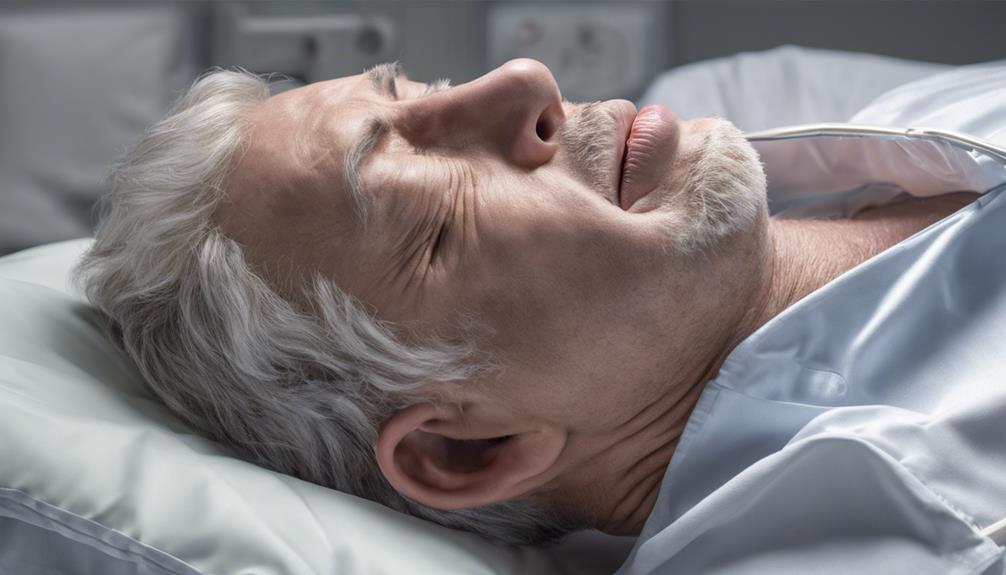Deep Brain Stimulation (DBS) is a valuable treatment choice for managing Parkinson’s disease, but as a caregiver, it is crucial to comprehend its intricacies. Your role in preoperative assessments and postoperative monitoring is essential. This involves keeping track of the patient’s reactions, managing any necessary adjustments, and staying alert to potential neuropsychiatric changes. It is important to maintain realistic expectations regarding the benefits of DBS, as it does not cure Parkinson’s. Emotional and physical challenges may arise, so it is important to ensure you have a support system in place. By understanding these aspects, you can provide better support to your loved one and navigate this journey more effectively. More insights on this topic are available for you.
Key Takeaways
- Deep Brain Stimulation (DBS) is a surgical treatment for Parkinson's that helps manage motor symptoms but does not cure the disease.
- Caregivers must monitor patients for side effects, device malfunctions, and assist with follow-up appointments after DBS surgery.
- Realistic expectations about DBS outcomes are essential; improvements in motor symptoms do not eliminate non-motor symptoms or medication needs.
- Neuropsychiatric changes may occur post-DBS, including mood swings and anxiety, requiring caregiver awareness and support.
- Caregivers can benefit from educational resources, support groups, and counseling to manage the emotional toll of caregiving.
Understanding Deep Brain Stimulation

Deep Brain Stimulation (DBS) represents a significant advancement in treating Parkinson's disease. This surgical procedure involves implanting electrodes in specific areas of your brain, primarily targeting the subthalamic nucleus (STN) and globus pallidus interna (GPi).
If you're experiencing significant motor symptoms despite ideal medication, DBS may be an option after at least four years of living with Parkinson's. It's important to evaluate the potential side effects of any treatment, including cold medications, which can interact with other therapies.
During the surgery, your doctor will modulate abnormal electrical signals in your brain, helping restore smoother communication among brain cells. This process alleviates symptoms like stiffness, slowness, and tremors.
You'll undergo a preoperative assessment, and the lead implantation occurs while you may be awake to guarantee ideal electrode placement. Afterward, a neurostimulator is implanted under your collarbone for continuous electrical stimulation.
While DBS can dramatically reduce motor symptoms and lessen medication dependence, it's vital to understand it doesn't cure Parkinson's disease. Non-motor symptoms often remain unaddressed, so ongoing follow-up and adjustments are necessary to enhance treatment outcomes.
Understanding DBS can empower you and your caregivers to make informed decisions about managing Parkinson's effectively.
Role of Caregivers

As a caregiver for someone undergoing Deep Brain Stimulation (DBS), you take on significant responsibilities that can reshape your identity.
You'll need to adapt as your loved one's needs change post-surgery, which can be both challenging and rewarding. Understanding these dynamics is essential for maintaining your well-being while providing the best support possible.
It's also important to take into account financial planning as medical expenses can add up, impacting your overall financial health.
Caregivers should be aware of their own financial situation to guarantee they can provide consistent care without added stress.
Caregiver Responsibilities Post-DBS
Caregivers are pivotal in the journey following Deep Brain Stimulation (DBS) for Parkinson's patients. Your role involves monitoring the patient's response to the procedure, tracking improvements in motor symptoms, and noting any side effects that may arise.
Regular postoperative follow-up with healthcare professionals is essential, as you'll often assist with adjusting neurostimulator settings and medications to optimize treatment outcomes. Understanding financial considerations for elderly care can also be beneficial as you navigate the costs associated with ongoing treatment and support.
Emotional support is vital, too. You may experience anxiety and uncertainty regarding the effectiveness of DBS and any potential neuropsychiatric changes in the patient. Being aware of the signs of infection or device malfunction will help you communicate concerns promptly with medical providers, ensuring timely intervention if complications arise.
Moreover, engaging in caregiver support groups can provide valuable resources and shared experiences. These groups can help you manage caregiver burden while promoting self-care amidst your responsibilities.
Impact on Caregiver Identity
Steering through the aftermath of Deep Brain Stimulation (DBS) can considerably alter how you see yourself as a caregiver. You might find yourself grappling with your identity and responsibilities, as DBS changes your loved one's capabilities. This shift can lead to profound self-awareness and a return to viewing yourself as more than just a caregiver.
As you navigate this change, it's vital to recognize that emotional and psychological growth occurs in stages, and seeking help can facilitate that process key domains of development.
- You may question your role in the caregiving dynamic.
- Your personal needs may become more visible.
- A support system can be essential for your well-being.
Over time, many caregivers report feeling more comfortable reassociating as spouses rather than solely caregivers, especially five years post-DBS. This shift reflects an evolution in your identity, allowing you to reclaim aspects of yourself that may have diminished while caring for someone with Parkinson's disease.
However, it's important to acknowledge the isolation that often accompanies caregiving. To foster well-being, consider seeking support systems that resonate with your experiences. By embracing this journey, you can cultivate a sense of self that honors both your caregiving role and your individual identity.
Preoperative Considerations

Preoperative Considerations
Candidates for Deep Brain Stimulation (DBS) undergo a thorough preoperative evaluation to confirm they're suitable for the procedure. This evaluation includes extensive preoperative assessments, where the patient's medical history and medication regimen are reviewed alongside an evaluation of cognitive function.
It's essential to determine if your loved one meets the criteria, which typically requires at least four years of Parkinson's disease symptoms and ongoing motor complications despite ideal treatment. Additionally, understanding any potential co-occurring mental health disorders, such as chronic feelings of emptiness, is important in this evaluation process.
Neuropsychiatric evaluations play a significant role in this process, helping identify potential risks and preparing you as a caregiver for any possible mood changes post-surgery. Understanding these aspects can help you manage expectations and provide emotional support during recovery.
Education on realistic expectations regarding DBS outcomes is important, as it can alleviate concerns and enhance satisfaction with the treatment process.
Engaging in multidisciplinary care, involving neurologists, neurosurgeons, and mental health professionals, guarantees a well-rounded approach to decision-making surrounding DBS surgery. By being informed and involved, you can better advocate for your loved one's needs and navigate the complexities of this life-changing procedure.
Postoperative Responsibilities

Following surgery, postoperative responsibilities require careful attention to guarantee a smooth recovery. As a caregiver, you'll play a crucial role in monitoring your loved one's health and ensuring the neurostimulator functions properly. Here are some key areas to focus on:
- Monitoring the surgical site for signs of infection, such as redness, swelling, or discharge. Additionally, incorporating gentle stretching and relaxation techniques can help alleviate stress during the recovery process, which may benefit overall well-being and healing yoga for back pain.
- Managing the neurostimulator by understanding its settings and tracking battery life for timely replacements.
- Scheduling follow-up appointments with a movement disorder specialist to discuss programming and any concerns.
You must keep the surgical site clean and dry to minimize the risk of infection. Be vigilant for any neuropsychiatric changes, like mood swings or cognitive disturbances, and provide the necessary support.
Educating yourself about signs of neurostimulator malfunction—such as changes in symptom control or unusual sensations—will help you respond promptly to any issues.
Regular follow-up appointments are essential for ensuring that the neurostimulator is correctly programmed and for addressing any concerns related to your loved one's symptoms. By staying proactive, you can appreciably contribute to a positive recovery experience.
Caregiver Burden Dynamics

Caring for a partner with Parkinson's disease can take a significant toll on your emotional and physical well-being, often leading to what's known as caregiver burden. This burden encompasses various challenges, including emotional, social, financial, physical, and spiritual strains that you might face.
The dynamics of caregiver burden often intensify, especially when non-motor symptoms and cognitive decline are present in your partner. While deep brain stimulation (DBS) may improve motor functions, about 50% of caregivers report disappointment with the patient outcomes. Factors like being female, cohabiting with the patient, and providing extensive care can elevate your burden. Additionally, caregivers may face further challenges when managing the non-motor symptoms that persist despite motor improvements from interventions like DBS. Some treatments, particularly medications such as gabapentin, may raise concerns about their impact on cognitive functions. Research into **gabapentin effects on cognition** suggests that the drug, typically used for neuropathic pain or seizures, can sometimes contribute to cognitive decline, compounding the complexities of caregiving in this context.
Here's a breakdown of key elements affecting caregiver burden:
| Factors | Impact on Caregiver Burden |
|---|---|
| Non-Motor Symptoms | Increased distress |
| Cognitive Decline | Higher emotional strain |
| Deep Brain Stimulation (DBS) | Variable outcomes; mixed feelings |
| Caregiver Gender | Females often report higher burden |
| Hours of Care | More hours lead to greater strain |
Understanding these dynamics can help you navigate the complexities of caregiving and seek support when needed.
Managing Expectations

When considering deep brain stimulation (DBS) for Parkinson's, it's essential to set realistic expectations about the outcomes.
While DBS can improve motor symptoms, it won't cure the disease, and you may notice neuropsychiatric changes that could impact caregiving.
Understanding the importance of active listening and communication can help in managing these changes effectively.
Preparing for these challenges can help you navigate the recovery process more effectively.
Realistic Outcomes After DBS
Understanding the realistic outcomes of Deep Brain Stimulation (DBS) is essential for caregivers maneuvering the complexities of Parkinson's disease treatment. While DBS can greatly improve motor symptoms, it's imperative to remember that incorporating a balanced diet and regular exercise can also play an essential role in managing overall health and enhancing the effectiveness of treatment.
For caregivers, adopting lifestyle for longevity can help in coping with the stresses of caregiving.
- Approximately 50% of caregivers report disappointment in outcomes despite some improvements.
- DBS won't completely eliminate symptoms; many patients still need medication for ideal relief.
- Unrealistic expectations can increase caregiver burden and dissatisfaction.
As a caregiver, it's essential to set realistic expectations regarding symptom relief. DBS can enhance quality of life, but it's not a cure.
You'll likely find that postoperative changes may complicate your caregiving role, impacting both the patient and your own well-being. Regular follow-ups and assessments are key to managing these changes, ensuring that both the patient and you receive the support you need.
Long-term care involves adapting to these realities, so it's important to communicate openly with healthcare providers and seek additional resources if necessary.
Understanding Neuropsychiatric Changes
Neuropsychiatric changes often emerge after Deep Brain Stimulation (DBS), and recognizing these shifts is important for both patients and caregivers. These changes can include mood swings, anxiety, depression, and apathy, which may greatly impact your quality of life.
It's essential to manage your expectations; many caregivers express disappointment despite improvements in motor function. About 50% report feeling let down, often due to unrealistic expectations surrounding DBS outcomes. Additionally, incorporating complementary therapies, such as essential oils for anxiety relief, might provide additional support in managing these symptoms.
Preoperative education about potential neuropsychiatric side effects is crucial. Understanding these risks can help you better prepare and reduce anxiety related to postoperative realities.
Furthermore, be mindful that neuropsychiatric symptoms in patients can increase your own stress and burden. This highlights the importance of mental health support for both you and the patient.
Long-term follow-up care is important in addressing any neuropsychiatric changes that arise post-DBS. Regular check-ins with healthcare providers guarantee that both you and the patient receive the necessary support.
Preparing for Postoperative Challenges
After Deep Brain Stimulation (DBS), it's important to manage your expectations regarding the surgery's outcomes. While DBS can notably improve motor symptoms of Parkinson's disease, non-motor symptoms may persist, leading to disappointment if you're not prepared.
Understanding the significance of trust issues with boyfriends can help caregivers navigate emotional challenges during recovery.
- Understand that neuropsychiatric side effects, like mood changes or cognitive decline, can occur.
- Anticipate a lengthy adjustment period as the neurostimulator is fine-tuned for best results.
- Keep in mind that about 50% of caregivers report disappointment with DBS outcomes.
As a caregiver, you'll need to communicate regularly with healthcare providers, allowing time for programming adjustments. This period can take several months, so patience is critical.
It's also important to recognize how your mental health may be affected; caregiver burden can increase if expectations aren't realistic. Regular follow-ups to assess both the patient's progress and your well-being are essential.
Neuropsychiatric Symptoms

Parkinson's disease (PD) often brings a host of neuropsychiatric symptoms that can complicate both patient and caregiver experiences. Symptoms like depression, anxiety, and apathy frequently emerge, considerably affecting caregivers' quality of life.
As a caregiver, you may feel increased emotional distress and burden when your loved one's neuropsychiatric symptoms worsen, sometimes overshadowing the relief gained from deep brain stimulation (DBS).
It's vital to understand that approximately 50% of caregivers report disappointment with DBS outcomes, especially when neuropsychiatric side effects continue or even worsen after surgery. This direct relationship between neuropsychiatric symptoms in PD patients and increased caregiver burden highlights the notable emotional toll on you as a caregiver.
To navigate these challenges, educating yourself about potential neuropsychiatric changes following DBS can set realistic expectations and help reduce anxiety regarding postoperative outcomes.
Thorough support systems are essential, so don't hesitate to seek resources that can assist both you and your loved one. By acknowledging these neuropsychiatric symptoms, you can better prepare for the complexities of caregiving while ensuring that both you and your loved one receive the support you need.
Long-Term Outcomes

Seeing significant improvements in motor symptoms, many patients who undergo Deep Brain Stimulation (DBS) for Parkinson's Disease enjoy a better quality of life for over five years. However, the long-term outcomes can vary, and it's vital for you as a caregiver to manage expectations.
- About 50% of caregivers report disappointment with DBS outcomes despite improvements in motor function.
- Caregiver stress may increase if patients experience neuropsychiatric side effects, while those without such issues often see a reduction in caregiver burden.
- Over time, many caregivers feel more comfortable reassociating as spouses rather than just caregivers.
Ongoing follow-up care is essential to optimize DBS settings and address new challenges. This guarantees that both patient and caregiver needs are met, keeping the focus on quality of life.
It's important to stay engaged in follow-up appointments to monitor progress and adjust strategies as needed. Remember, while DBS can lead to significant improvements, individual experiences may differ.
Resources for Caregivers

As you continue to support your loved one following Deep Brain Stimulation (DBS), having access to the right resources can make a considerable difference in your caregiving journey.
Start by seeking educational resources that explain the DBS procedure, its potential outcomes, and the emotional impact on both you and your loved one. Understanding the neuropsychiatric side effects associated with DBS is essential, as it prepares you to manage these changes effectively.
Consider joining support groups, whether in-person or online. These platforms allow you to share experiences, challenges, and coping strategies with fellow caregivers who understand your situation.
Additionally, don't underestimate the importance of mental health resources. Counseling or therapy can help you process the emotional toll of caregiving and navigate the changes brought by DBS.
Utilizing caregiver support services and respite care can considerably reduce your burden, allowing you to maintain your own well-being while providing the best care possible.
Frequently Asked Questions
What Should I Avoid After Deep Brain Stimulation?
After deep brain stimulation, you should avoid high-impact sports, sudden movements, and devices emitting strong electromagnetic fields. Keep surgical sites clean to prevent infections, and monitor battery life regularly to ascertain peak device performance.
What Do Caregivers Need to Know About Parkinson's?
"Knowledge is power." As a caregiver for someone with Parkinson's, you need to understand symptoms, manage expectations, and seek support. Staying informed helps you cope with challenges and fosters a healthier relationship with your loved one.
What Should You Not Say to Someone With Parkinson's Disease?
You shouldn't say things that minimize their experience, like "You don't look sick," or offer oversimplified advice such as "just try harder." Each person's journey with Parkinson's is unique and deserves understanding and respect.
What Is the Recovery Time for Deep Brain Stimulation for Parkinson's Disease?
Imagine a butterfly emerging from its chrysalis. After Deep Brain Stimulation, you'll spend about 24 hours in the hospital, then gradually recover at home. Within weeks, you can resume normal activities, but patience is key.
Conclusion
In steering deep brain stimulation for Parkinson's, you play an essential role in your loved one's journey. Your support can be as transformative as the procedure itself, helping them regain control of their life. Remember, managing expectations and being aware of neuropsychiatric symptoms can make all the difference. You're not just a caregiver; you're a beacon of hope in their fight against this condition. Always reach out for resources and support—you're not alone in this incredible journey.










